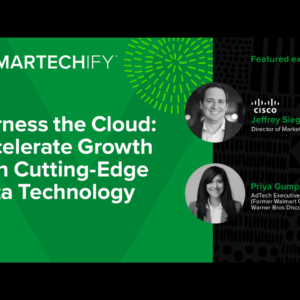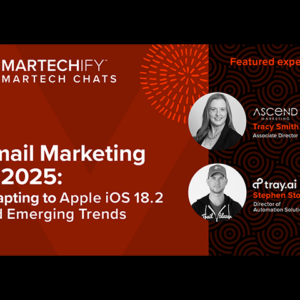Session Recap
Total Experience: Connecting Online and Offline Channels
October 19, 2023 – During this Martechify session, three of today’s top experts in omnichannel marketing discussed the opportunity in connecting channels to take your marketing campaigns to a whole new level of performance, as well as the complexities that arise during the journey.
This lively—and often entertaining—forum, moderated by Rich Herbst of Ascend Marketing, included Michelle Hagen Slade of Dodge Construction Network, Christina Pedison of Pizza Hut, and Joyce Schofield of The Container Store.
If you missed the event or want a refresher of any part of the conversation, read the summary below for the highlights or click below to watch the entire event video.
Featured experts
Hitting the high points: Key expert takeaways
Life in a multi-channel world
The word “more” seemed to dominate this discussion: with more communication channels and more data than ever before, brands and marketers can do more to enhance the customer experience across different channels and platforms. In turn, customers have more opportunities to interact with brands than ever before and more choices for how they prefer to engage: in-store, online or in-app; through social channels; or through live events and other experiences. As these opportunities grow, so does the need to lean on technology and data to create seamless, integrated experiences that connect all the marketing channels—which is no easy feat.
During this discussion, our experts highlighted a wide range of some of the most common hurdles of creating a total customer experience, divided into two major buckets:
1. Challenges in connecting channels
Integrating systems and channels to connect the various technologies and systems and ensure a 360-degree view of the customer, through consistent, seamless communications across channels.
Activating channels without conflicts or overlaps to create a unified marketing effort.
Ensuring data quality and usability to ensure it’s clean and actionable for marketing purposes.
Synthesizing data from multiple sources to perform in-depth analytics and make data-driven decisions.
Attributing and optimizing marketing programs and budgets for maximum effectiveness.
2. Challenges in balancing customer engagement
Looking at engagement through the lens of what the customer’s intentions are, assessing the impact of different touchpoints along the customer journey and predicting the next best engagement.
Maintaining the balance between engaging customers and over-contacting them.
Understanding the full customer lifecycle to focus on how you are reaching them across the entire campaign timeline and how the messages all come together as a whole.
Balancing short-term sales vs. long-term brand loyalty, especially among younger, more culturally diverse audiences.
Measuring activations and knowing their impact on sales and brand loyalty.
Technology solutions: What they do and how they help
Martech tools can help you create and deliver a level of customer experience excellence that may otherwise be out of reach. But finding the solutions that fit your specific needs and implementing them is not usually a quick or easy process, and even the most advanced technology can come with its own set of challenges. Our experts shared some of their own experiences with martech.
But first, here’s a rundown of some of the most common tools and their benefits:
Customer data platforms (CDPs) centralize and manage customer data for a better understanding of customer behavior.
Cross-channel campaign platforms run marketing campaigns across multiple channels for greater efficiency.
Customer experience platforms enhance the overall customer experience.
Multi-channel communication tools consolidate various communication channels for better customer engagement.
Journey orchestration tools orchestrate customer journeys across multiple channels to streamline marketing efforts.
Real-time decisioning tools determines the next best action, experience or offer for a customer in real time.
Headless content management systems provide flexibility and efficiency by managing and delivering content across multiple channels.
Integrated point-of-sale systems connect in-store or onsite retail shopping experiences with digital marketing efforts.
Integrated event platforms manage events for optimized online-offline marketing experiences.
Integrated analytics platforms consolidate and analyze data from various sources to support data-driven decision-making.
Straight from the Martechify experts: Real-life use cases and scenarios
Christina Pedison
Media Manager, Pizza Hut
Christina, who leads Pizza Hut’s national media as well as media partnerships, shares the details of the brand partnership with Teenage Mutant Ninja Turtles (TMNT) and their most recent movie, Mutant Mayhem. The partnership was a great opportunity, and a natural fit, thanks to the strong affinity between pizza and TMNT and their appeal to multiple audiences and demographics. The challenge of the partnership was the need to balance the branding with the hard-hitting sales message for Pizza Hut’s “Big New Yorker” product for a successful campaign.
The result was a true 360 campaign, involving multiple channels, including Pizza Hut’s website, emails, in-store print materials and custom-branded packaging. It also included activations at events like VidCon, engagement with YouTube creators, influencer gifting of custom Pizza Hut jackets and even a custom AR game where players act as pizza delivery drivers for the Turtles. A unique PR stunt in New York City kicked off the whole campaign, based on underground deliveries of Big New Yorker pizzas ordered by texting a turtle emoji.
One standout from the campaign was the custom animated video for both linear and online video. It was created by the movie’s animators with the movie actors providing their voices. The hard part? Balancing all of these efforts with promoting the Pizza Hut brand and achieving sales targets. Christina describes it as the “arc of understanding what is really the mix of that branded message. How do we become the cool pizza brand and culture but also make sure we’re hitting the sales metrics?”
The marketing also involved experiential marketing with branded Pizza Hut fire vans, which brought high engagement. Even the store employees went all-in on the experience by decorating the stores and dressing up as the Turtles.
The results of the overall campaign were impressive, including over 1 billion impressions from the PR stunt in NYC, substantial social media engagement, and over 1 million game play impressions.
Behind all that marketing flurry is the challenge of measuring the campaign’s impact accurately and determining that one big number that reflects its success, like how many new Pizza Hut fans resulted from this campaign. Christine mentioned the hurdle of adding up all the activity across all the different channels to come up with a way to report on how much affinity for the brand changed because of the partnership. Part of that process is identifying numbers like new followers Pizza Hut gained from the social channels, measuring increases in loyalty program activity, and working closely with their partners for ongoing data to better understand the long-term impact of the brand partnership.
Michelle Hagen Slade
Senior Vice President of Marketing, Dodge Construction Network
Michelle is a former agency owner and now leads marketing for Dodge Construction Network, a company that collects and sells data related to construction projects across the country. They work with companies like Turner, which is one of the largest general contractor firms in the country, as well as Caterpillar and Sherwin-Williams, helping them with forecasting. They also work with the government to inform the forecasting model for Gross Domestic Product (GDP). The company’s teams of economists and data scientists actively collect and document large amounts of data—one trillion data points—and Michelle is focused on leveraging them.
Her challenge is not with the data but with the marketing side of the company. The lack of integrated communication channels makes a 360-degree view of their customers challenging. The marketing team currently works with a very simple martech stack, relying heavily on a single channel with email and email campaigns, knowing that there is opportunity give their customers the data they need across the entire lifecycle of construction.
Michelle describes the success of their first multi-channel campaign, an effort that’s already generating revenue after just a few weeks in market and highlights the power of delivering the right message at the right time without over-communicating with customers.
Her team is in the process of documenting the customer journey, which is quite long in commercial construction because it starts with planning the construction years in advance, making data relevance and timeliness critical.
She shared a data model developed by the company’s data scientists, emphasizing that while they have an abundance of data, there is currently no connection to a customer experience (CX) platform. With so much data, it’s easy to get overwhelmed, so Michelle’s approach is to start as simply as possible. Despite the complexities of the customer journey, she is intent on utilizing the massive volume of data available to her team to improve customer experience and communications in the commercial construction space.
With so much data comes so much challenge…not with the data itself, but with the accessibility and activation of the data. Currently, the data lives in models that aren’t yet accessible for practical use, which makes it difficult to create a better customer experience. Michelle knows the importance of understanding the pain points customers experience in consuming vast amount of data, pinpointing where the largest pain points are most significant in the customer journey and determine how to activate the data to address those needs.
Though the company is starting from scratch, it doesn’t have a lot of technical debt and has a wealth of data that can be leveraged once they find the right stack architecture for their needs.
Joyce Schofield
Head of Product & User Experience, The Container Store
Joyce has been in the technology space for over 23 years, with 17 years spent as a product leader, and is passionate about being in spaces where she can touch and address customer experience. In her current role for The Container Store, she leads “all things technology,” including e-commerce, marketing, stores, merchandising, supply chain logistics, finance, and the company’s custom area.
She shares The Container Stores’s mission to transform lives through the power of organization, taking customers’ lives from chaotic to organized with a delightful experience. The company’s strong brand affinity is shown by customers wanting to spend hours in The Container Store and referring to it as their “happy place.”
Joyce explains the two parts to the business: one is general merchandising and the other is custom spaces. In terms of general merchandising, the company thinks of itself as a “lifestyle” and “lifetime brand,” creating spaces in a customer’s home suited to the life they are living in it. The custom space business offers customers a way to build out any design and any space, created specifically for them.
To deliver on that promise, having the right martech is critical. Joyce shares their recent investment in leveling up by adding technology that helps the company solve for the seamless customer experience, such as Salesforce Marketing Cloud. This technology empowers her teams to realize their dream of journey mapping to enhance the customer experience. Their customer data platform (DCP) was upgraded recently, and they have a new platform to enable headless content management systems (CMS). The customer experience is also boosted by the recent rebranding and launch of the new loyalty program, Organized Insider. These investments and capabilities, combined, give Joyce and her teams confidence in executing a 360-degree customer journey.
Joyce presented three distinct use cases that give insights into The Container Store’s customer experience strategy:
Inspiring and engaging storytelling across touchpoints, driving customers to visit their local Container Store because of the excitement and engagement it brings, then replicating that experience digitally by bringing the in-store storytelling online.
Customer journey mapping based on data analysis, which includes combining behavior signals and data to figure out the next best action and next best experience to put in front of the customer. The goal—for example, to drive the next purchase or to introduce the customer to an adjacent department—calls for building out the customer journeys and triggers to lead to that outcome.
End-to-end digital experience for custom spaces, which involves creating efficient and delightful experiences for the store’s associates as well as their customers. Here, data is again vital to determining where the customer is in the journey, meeting them at that point and helping them move to the next step. The end-to-end journey includes understanding interactions the customer had all along the way, including after a visit or purchase.
Joyce emphasizes the importance of a digital framework and making sure to capture all the signals and the data because of the critical role they have in achieving goals. Data is gathered from various sources, including transactional data, surveys, in-store signals and customer interactions. Personalization can be enhanced by integrating data signals from different platforms and vendors.
A big thank you to Christina, Michelle and Joyce for sharing their valuable experiences and insights with the Martechify community. Stay tuned for our next event topic and speaker lineup!
Related resources
New to this topic? Find helpful external links below.
Watch the recording
For more insights and takeaways from the session, watch the full recording here:













